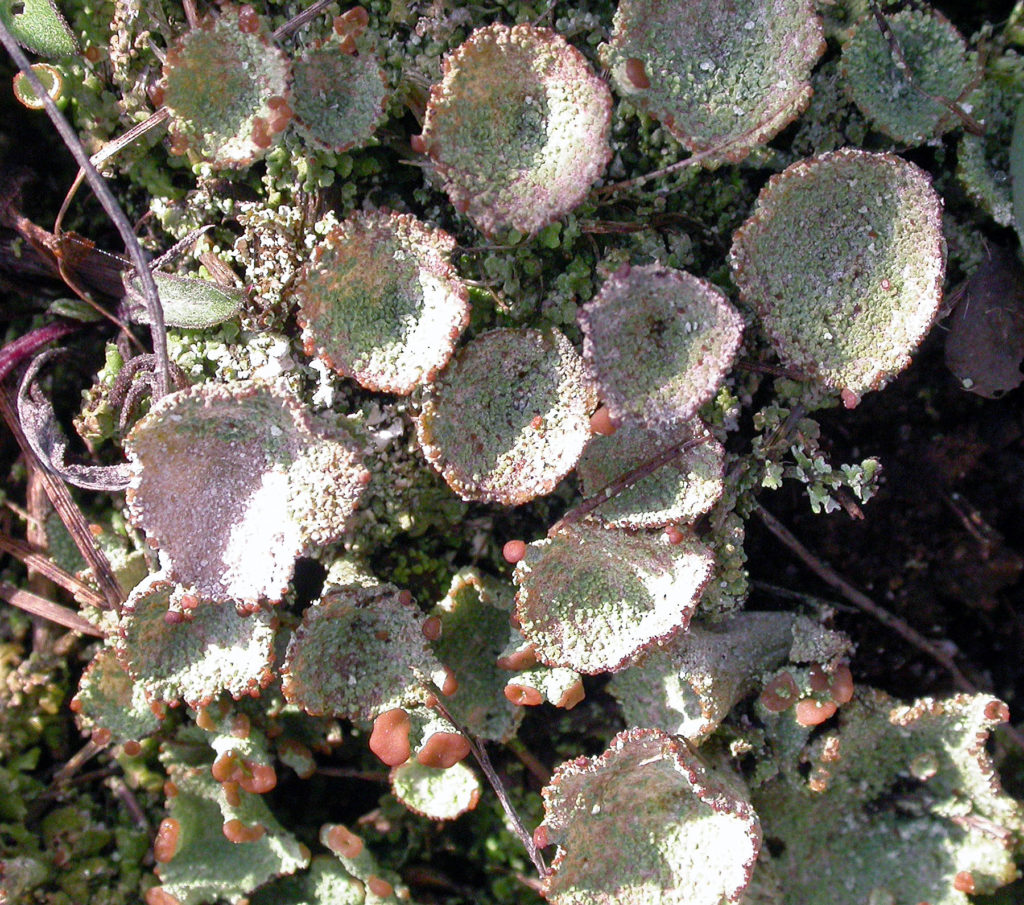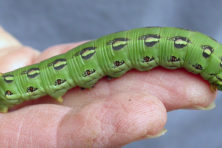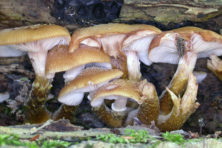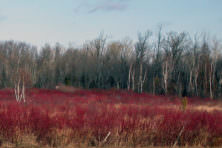Roy & Charlotte Lukes: Colorful Lichens
- Share
- Tweet
- Pin
- Share

Invariably there comes a time in December when the outdoor air temperature remains above freezing for several days. Deciduous plants have lost their foliage, the woods are “bare bones” and we will have to wait around four months for flowering plants to come into bloom.
One group of native plants, however, can be at its yearly best during these mild breaks in the weather. There are no drought conditions to discolor and dry them out, and the readily available moisture makes the intricate beauty of these seldom-noticed plants reach their very best. I speak of the lichens.
It doesn’t surprise me one bit that the great majority of people couldn’t care less about these miniature, inconspicuous plants. Unfortunately, they don’t produce colorful blossoms and, to make matters worse, few have common names.
Who in their right mind would get carried away with Trypethelium virens or Verrucaria nigrescens? How does one pronounce them in the first place? Many little kids all over the world can easily rattle off the long, cumbersome scientific names of a dozen or more dinosaurs or other prehistoric animals, but there’s excitement attached to these creatures. The scientific names of lichens and most other plants sadly go begging.
Strong winds recently did some natural pruning in the woods, and on a walk down our driveway I came across a basswood branch loaded with colorful lichens. Soon I was seated at my desk, peering through a hand lens at the interesting shapes and colors of the crusty gray-green lichens.
At first I thought the specimen was in the genus Parmelia (par-ME-lee-a), one of the lichens used by ruby-throated hummingbirds in the construction of their nests. After more examination, followed by poring through some references, I decided it was an Anaptychia (an-ap-TYKE-ee-a) lichen. It was prominently margined and contained fascinating blackish discs.
Each roundish “fruiting” disc is called an apothecium (a-po-THEE-see-um) – plural would be apothecia – and it contains spores which are vital to the reproduction of the plant. Lichens, mushrooms, mosses, ferns, clubmosses and horsetails are among those plants which reproduce from spores – as opposed to garden vegetables and flowers which reproduce from seeds.
There are two well-known and admired lichens of this region which can grow to a half-inch, or even taller, and whose fruiting bodies have been given common names. One, the British red soldier lichen, Cladonia cristatella (cla-DOE-nee-a cris-ta-TEL-la), has gray-green “stems” topped off with red-tipped fruiting bodies. It often grows on rotting wood.

The cup-shaped tops of pixie cup lichens produce spores that are splashed out with rain. Photo by Roy Lukes.
The other familiar relative in the same Cladonia genus is the pixie cup lichen, whose appearance reminds me of a golf tee. Their tiny tops act as splash cups. Raindrops fall into them and rebound away from the plant, carrying with them the spores needed for reproduction.
There’s another lichen of this region that quite a few hikers know. It is the reindeer moss lichen. Here is a plant that grows upright like a moss, so, unfortunately, it is commonly called a moss when in reality it is a lichen. Reindeer lichens during mild humid weather can be as comfortable and soft to the touch as a wet sponge.
The scientific name of the reindeer moss lichen is Cladina rangiferina (cla-DIE-na range-if-er-EYE-na) and it is greenish-gray in color. Reindeer in the far north prefer to eat a related yellowish species, Cladina mitis (MY-tis), due to its milder taste. Mita refers to being mild since this species contains less usnic acid than other related species.
There are roughly 37,000 species of lichens in the world and more than 3,600 just in North America. Wisconsin is home to about 600 species while one could find about 2,000 species in the Arctic.

A close look at the pixie cup lichen can remind you of a golf tee. Photo by Roy Lukes.
Your search for lichens in large industrial cities will usually end in failure. Even though lichens adapt by making use of small amounts of moisture and can make their food in a hurry, they are extremely intolerant of polluted air.
Naturally, I revel in the pristine beauty of old-growth woods such as the “Point” near Baileys Harbor, where a botanist friend has recorded 129 species of so-called macrolichens. This group does not include quite a few of the tiny crustose lichens, some of which appear as little more than thin black dirt on rocks or as whitish dusty material on cedar trees.
The most colorful large lichen Charlotte and I have ever seen was growing on a bald cypress tree in the Corkscrew Swamp in southwest Florida, a place we visited in March of 2003. One look at it and you can understand why its common name is the Christmas lichen. It is quite large and easy to find.
One of my favorite lichens in this part of the state is the old man’s beard lichen, a member of the Usnea (UZ-nee-a) genus. Don’t confuse the old man’s beard lichen with the Spanish moss that grows in long lacy forms from big branches of live oaks and other trees in the South. These lovely plants are actually flowering plants belonging to the pineapple family.
Usnea lichens have about 600 species in the world. Their identity depends largely upon their intricate branching patterns. They are virtually extinct today in all of Europe due to the extremely high degree of air pollution there. I dread the day when these lichens disappear from this region of northeastern Wisconsin because a favorite warbler, the northern parula, builds its nest in hanging clusters with these fussy plants.
I view lichens as coal miners of many years ago who depended on their caged canaries. The canaries by simply remaining alive inside the deep mines would signal to the underground workers that the air was safe to breathe.
Even though they are silent and very small, the lichens speak: “This fresh, healthful air appeals to us. We like it here, so please help keep the air clean!”




